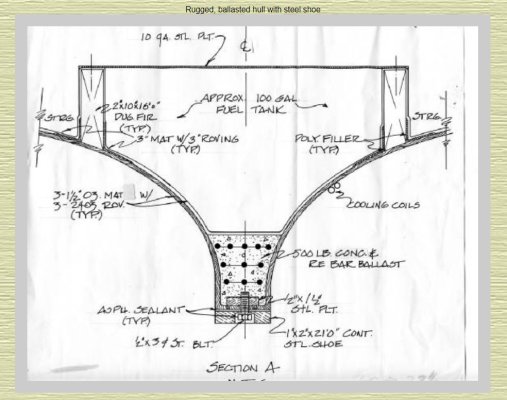ak-guy
Senior Member
My 36 year old Allweather has a 112 gallon fuel tank which is a lot for a boat that burns 1/2 to 3/4 gallons an hour. The tank is the floor of the main cabin, You are walking on the steel top. I am not sure what kind of steel it is but it is magnetic and fairly thick as there is no flex. The rest of the tank is fiberglass. I recently fill up the tank to within a couple inches of the top, I had never filled it that much before. The boat is on a mooring and sometimes is rolling quite a bit in certain conditions. Today I noticed that there are several places around the perimeter of the top of the tank that are leaking slightly. The fuel in the rough conditions is sloshing up around the edges. There are no leaks anywhere else. The amount is very small but in several places. There is a raised edge all around the perimeter that joins the steel tank top to surrounding plywood. The lid must be fastened somehow to the stringers and sealed somehow. It would be fairly straight forward to grind down that ridge and redo it but the new bond to the steel might be a problem.




 They are like a punch that punches out little rectangles of metal.
They are like a punch that punches out little rectangles of metal. , I've used them to fabricate odd shaped sheet metal pieces in a past life. If I were going to cut a large tank up in place I would go the nibbler route first. Because of the way they cut, there are no sparks, they literally punch the metal out and go through it like butter. Because of the size of the tool and the fact you have to have the head on both sides of the cut, you'd have to cut the tank into more pieces to access it all and make the best use of the tool, but because of how fast it goes it still wouldn't be that big of a deal...now if you wanted to save it intact to make a pattern...
, I've used them to fabricate odd shaped sheet metal pieces in a past life. If I were going to cut a large tank up in place I would go the nibbler route first. Because of the way they cut, there are no sparks, they literally punch the metal out and go through it like butter. Because of the size of the tool and the fact you have to have the head on both sides of the cut, you'd have to cut the tank into more pieces to access it all and make the best use of the tool, but because of how fast it goes it still wouldn't be that big of a deal...now if you wanted to save it intact to make a pattern... 